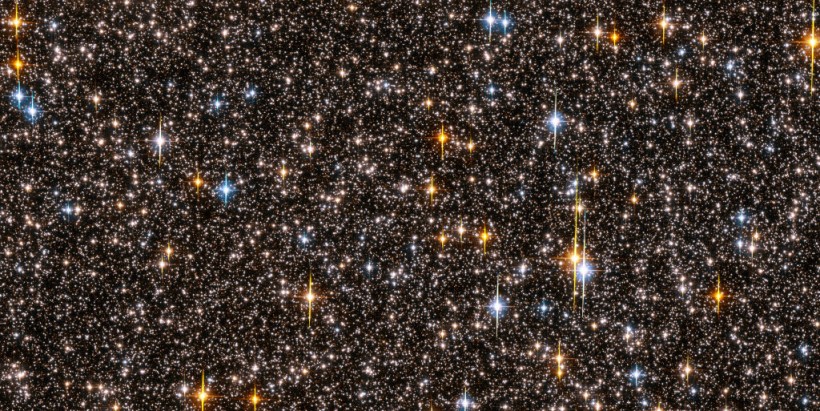Astronomers found a new form of star that is entirely perplexing. Instead of hydrogen and helium, the stars' surfaces are coated with oxygen and carbon. According to astronomers, they might result from a strange and unusual star collision.
IFL Science suggests considering how stars create elements to see why this is unusual. Stars fuse hydrogen atoms into helium in their cores for most of their lifetimes. When the hydrogen in the atmosphere runs gone, stars become red giants and begin fusing helium into carbon and oxygen. If they aren't huge enough, they leave behind a helium white dwarf, which contains just traces of carbon, oxygen, and nitrogen constitutes helium's ashes.
Researchers detailed their study, "Discovery of Hot Subdwarfs Covered With Helium-Burning Ash," in the Monthly Notices of the Royal Astronomical Society Letters.

Picture released 04 October 2006 by the European Space Agency shows one-half of the Hubble Space Telescope field of view with nine stars that are orbited by planets with periods of a few days.
German Astronomers Find Weird Stars Covered In Carbon, Oxygen
According to a recent article from the Royal Astronomical Society, a group of German astronomers led by Professor Klaus Werner of the University of Tübingen has identified two peculiar stars coated with a by-product of burning helium.
The Large Binocular Telescope and the Large Sky Area Multi-Object Spectroscopic Telescope, or LAMOST Survey, were used to find these stars.
The paper also discussed the discoveries of PG1654+322 and PG1528+025, underlining that these stars might have originated through a rare stellar merger event.
Unlike the typical stars, which have hydrogen and helium on their surfaces, the stars Werner and his colleagues discovered contained carbon and oxygen. Furthermore, according to legend, helium remains on top, which is an odd composition for a star.
When the new stars have temperatures and radii that indicate they are still burning helium in their cores, the notion becomes even more perplexing. This characteristic is more common in higher evolved stars than the ones Werner and his team analyzed.
In response, Werner, the primary author of the current article, stated that stars with all of these surface configurations are typically expected to have burned all of the helium in their cores and be on their way to becoming white dwarfs.
ALSO READ: NASA Hubble Space Telescope Spots a Weird Pair of Interacting Galaxies
The stars, according to Gizmodo, are dense and scorching, with surface temperatures ten times higher than our Sun. Their surfaces are one-of-a-kind because they're made up of carbon and oxygen, which are produced when helium burns.
Because the star identified by Werner's team is unique in its own right, astronomers from the University of La Plata and the Max Planck Institute for Astrophysics collaborated on a second paper that presents a hypothesis for its evolution.
In an email, astronomer Miller Bertolami, the primary author of the second paper, claimed that they believe Werner's unusual objects were created by a rare type of star merger.
Under the right conditions, a carbon-oxygen white dwarf might be perturbed and accreted by a partner, resulting in objects like those seen by Werner et al., according to Bartolami.
LAMOST, LBT Explained
According to the University of Arizona, the world's biggest telescope as of press time is the Large Binocular Telescope (LBT), which is presently housed at the Mt. Graham International Observatory. The Large Binocular Telescope, which was used to acquire the first photos of a planet in the formation, is utilized by astronomers all across the world.
LBT is made up of two identical 8.4-meter (28-foot) mirrors that are set side by side on a steerable platform. The telescope is built of steel and glass and weighs 600 tons.
The LBT is under 11,000 feet tall and is found in the Pinaleo Mountains in southwestern Arizona.
The LAMOST survey consists of two primary components: the LAMOST ExtraGAlactic Survey (LEGAS) and the LAMOST Experiment for Galactic Understanding and Exploration (LEGUE) investigations of Milky Way star structure.
The LAMOST system uses a large aperture telescope with a large field of view to feed a highly-multiplexed spectroscopic instrument, which is a new concept. LAMOST is a north-south meridian optical axis reflecting Schmidt telescope.
RELATED ARTICLE: Dying Moments of Planet While Being Consumed by White Dwarf Star Captured for the First Time
Check out more news and information on Space in Science Times.














